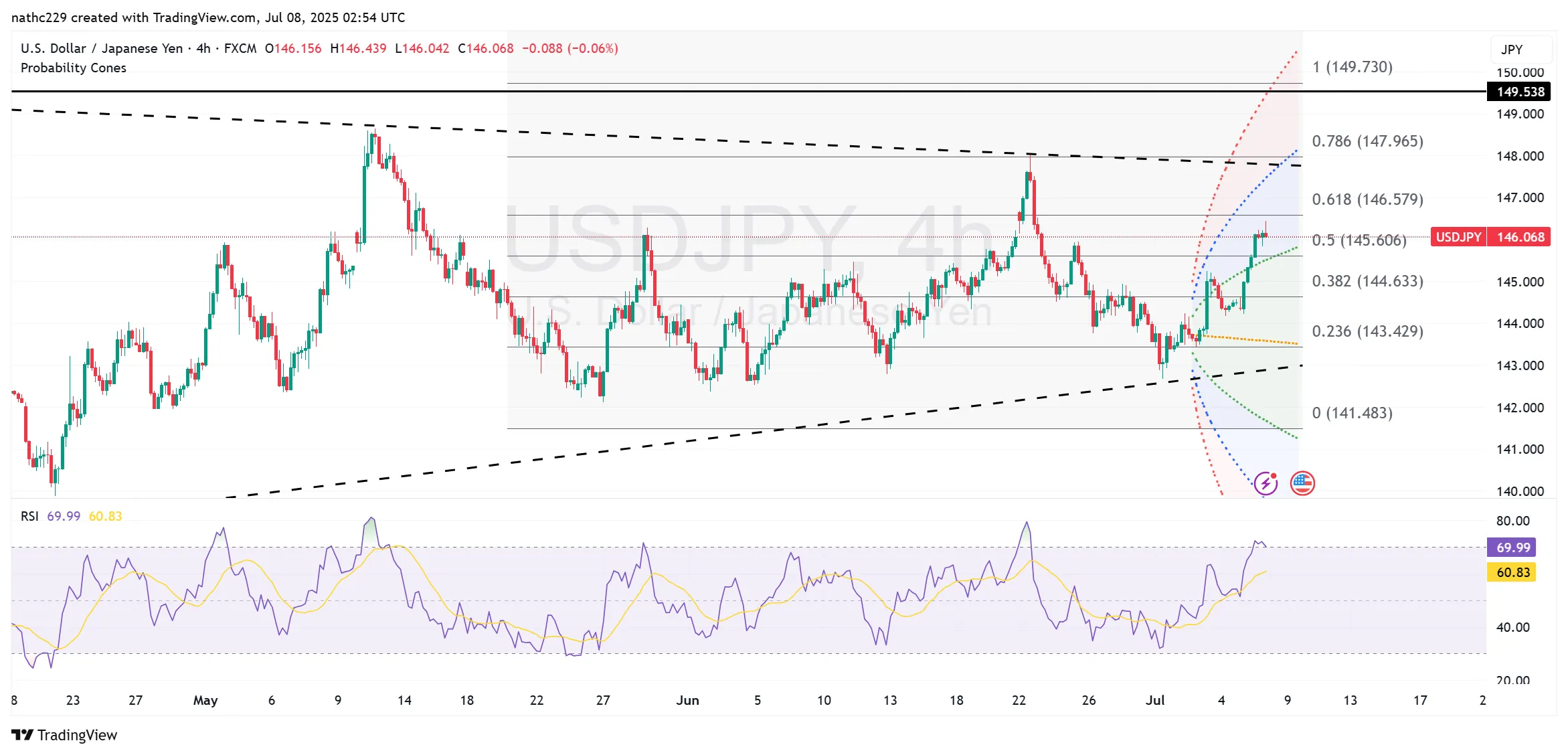
USD/JPY Breaks Above 146 as Trump Tariff Threat Amplifies Dollar Strength
USD/JPY Breaks Above 146 as Trump Tariff Threat Amplifies Dollar Strength
Overview
USD/JPY surged decisively above the key psychological and technical level of 146 following President Trump’s threat of implementing 25% tariffs on Japanese goods starting August 1. This announcement triggered increased demand for the U.S. dollar, driving Treasury yields higher and prompting further yen weakness. Investors and analysts are closely evaluating the technical outlook and broader economic implications of these developments.
Technical Analysis
USD/JPY surged above 146, overtaking the critical 100-day moving average (DMA) amid heightened volatility spurred by geopolitical and economic events. Immediate support levels are now identified at the Ichimoku cloud top at 145.55, the cloud bottom at 144.76, and the recent July 2 high at 144.25. These levels represent essential short-term technical supports that must hold to maintain bullish sentiment.
On the upside, immediate resistance stands at the upper Bollinger Band positioned at 146.32, closely followed by the May 29 high at 146.29. A break and close above these resistance points would reinforce bullish momentum, targeting further upward potential toward the significant resistance from the May 14 high at 147.67.
Technical momentum indicators further underscore the bullish sentiment. The Stochastic oscillator and the bullish crossover of short-term moving averages indicate robust upward momentum, suggesting potential for further USD/JPY gains in the near term.
Market Factors and Economic Indicators
The catalyst for the recent USD/JPY rally was President Trump’s announcement of proposed tariffs on Japanese imports, notably impacting the automotive sector. This announcement heightened investor concerns about the economic implications for Japan, a major holder of U.S. Treasuries and equities, exacerbating yen weakness due to the anticipated negative impact on Japanese economic activity and corporate profitability.
In response to the announcement, Japanese automaker stocks fell sharply, reflecting investor fears of potential earnings impacts and broader economic fallout. Continued equity market weakness in Japan could eventually drive increased demand for safe-haven assets, potentially supporting the yen. However, near-term expectations remain skewed towards further yen weakness given the immediate negative economic repercussions of the proposed tariffs.
Additionally, recent economic data from Japan contributes to the yen’s bearish outlook. Real wages in Japan fell significantly, recording their fastest decline in nearly two years, dampening expectations for potential monetary tightening by the Bank of Japan (BOJ). The BOJ’s continued dovish stance, alongside expansionary fiscal policies promised by political parties ahead of the July 20 Upper House elections, further undermines yen strength.
U.S. economic indicators, particularly recent strong employment data, have bolstered expectations for sustained Federal Reserve hawkishness. U.S. Treasury yields, especially in the shorter-term maturities, have risen accordingly, supporting continued dollar strength versus the yen.
Risks and Consequences
Despite the current bullish outlook for USD/JPY, several risks remain significant. Persistent declines in Japanese equity markets driven by tariff implications could ultimately stimulate renewed yen safe-haven demand, reversing current trends.
Moreover, political risks within the U.S., particularly concerning trade policy unpredictability and potential domestic backlash against tariffs, could introduce volatility. Economic retaliation or diplomatic tensions between Japan and the U.S. might exacerbate market uncertainty, heightening yen volatility.
From a technical standpoint, failure to maintain key support at the cloud top (145.55) or a reversal below the cloud bottom (144.76) could indicate a significant bearish shift, possibly signaling an end to the recent bullish run.
Trading Recommendations
Bullish traders should continue to monitor critical support levels closely, maintaining protective stop-loss orders slightly below key supports at 145.55 and 144.76. Confirmation of sustained moves above immediate resistance at 146.32 would support additional long positions targeting the May 14 high at 147.67.
Conversely, bearish traders may look for clear technical signals indicating a reversal below essential supports at the cloud bottom (144.76) before initiating short positions, targeting lower support zones.
Conclusion
USD/JPY’s technical and fundamental outlook remains bullish in the near term, driven by tariff threats, rising U.S. yields, and weakening Japanese economic indicators. Traders must vigilantly monitor developments in geopolitical dynamics, economic indicators, and critical technical levels to effectively navigate the evolving market landscape.
